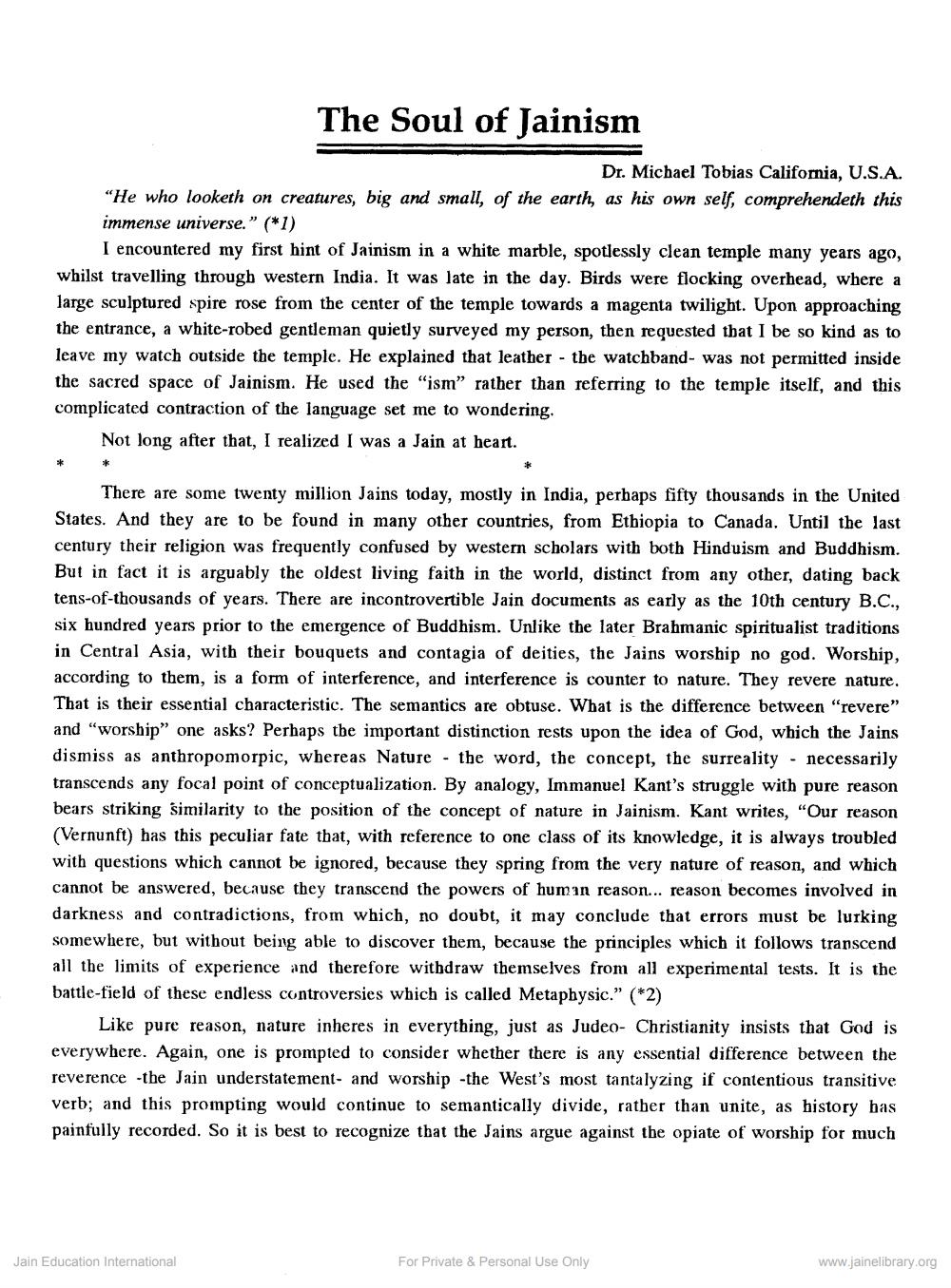________________
The Soul of Jainism
Dr. Michael Tobias California, U.S.A. “He who looketh on creatures, big and small, of the earth, as his own self, comprehendeth this immense universe." (*1)
I encountered my first hint of Jainism in a white marble, spotlessly clean temple many years ago, whilst travelling through western India. It was late in the day. Birds were flocking overhead, where a large sculptured spire rose from the center of the temple towards a magenta twilight. Upon approaching the entrance, a white-robed gentleman quietly surveyed my person, then requested that I be so kind as to leave my watch outside the temple. He explained that leather - tbe watchband- was not permitted inside the sacred space of Jainism. He used the "ism” rather than referring to the temple itself, and this complicated contraction of the language set me to wondering.
Not long after that, I realized I was a Jain at heart.
There are some twenty million Jains today, mostly in India, perhaps fifty thousands in the United States. And they are to be found in many other countries, from Ethiopia to Canada. Until the last century their religion was frequently confused by western scholars with both Hinduism and Buddhism. But in fact it is arguably the oldest living faith in the world, distinct from any other, dating back tens-of-thousands of years. There are incontrovertible Jain documents as early as the 10th century B.C., six hundred years prior to the emergence of Buddhism. Unlike the later Brahmanic spiritualist traditions in Central Asia, with their bouquets and contagia of deities, the Jains worship no god. Worship, according to them, is a form of interference, and interference is counter to nature. They revere nature. That is their essential characteristic. The semantics are obtuse. What is the difference between "revere” and "worship" one asks? Perhaps the important distinction rests upon the idea of God, which the Jains dismiss as anthropomorpic, whereas Nature - the word, the concept, the surreality - necessarily transcends any focal point of conceptualization. By analogy, Immanuel Kant's struggle with pure reason bears striking similarity to the position of the concept of nature in Jainism. Kant writes, “Our reason (Vernunft) has this peculiar fate that, with reference to one class of its knowledge, it is always troubled with questions which cannot be ignored, because they spring from the very nature of reason, and which cannot be answered, because they transcend the powers of human reason... reason becomes involved in darkness and contradictions, from which, no doubt, it may conclude that errors must be lurking somewhere, but without being able to discover them, because the principles which it follows transcend all the limits of experience and therefore withdraw themselves from all experimental tests. It is the battle-field of these endless controversies which is called Metaphysic.” (*2)
Like pure reason, nature inheres in everything, just as Judeo- Christianity insists that God is everywhere. Again, one is prompted to consider whether there is any essential difference between the reverence -the Jain understatement- and worship -the West's most tantalyzing if contentious transitive verb; and this prompting would continue to semantically divide, rather than unite, as history has painfully recorded. So it is best to recognize that the Jains argue against the opiate of worship for much
Jain Education International
For Private & Personal Use Only
www.jainelibrary.org




